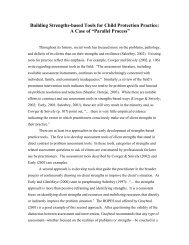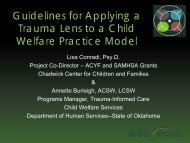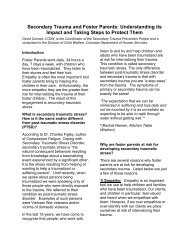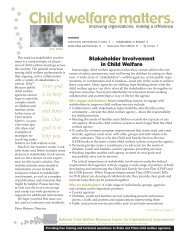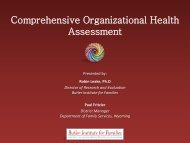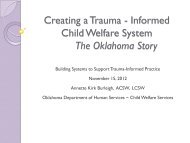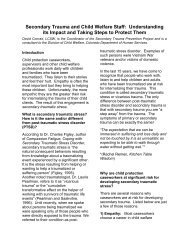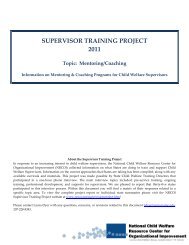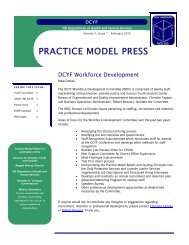Building a Model and Framework for Child Welfare Supervision
Building a Model and Framework for Child Welfare Supervision
Building a Model and Framework for Child Welfare Supervision
Create successful ePaper yourself
Turn your PDF publications into a flip-book with our unique Google optimized e-Paper software.
• Develop an internal process to identify practitioners who are potentially a “good fit” <strong>for</strong> the<br />
supervisory role. Using the organization’s current supervisory practice model, promote only<br />
individuals who display beginning competence in supervisory skills, excellent per<strong>for</strong>mance in<br />
their current positions, high motivation to undertake the dem<strong>and</strong>s of the position, <strong>and</strong><br />
commitment to continue to develop in the role through supervision <strong>and</strong> mentoring.<br />
• Provide a program of preparation <strong>for</strong> supervisors new to the<br />
position <strong>and</strong> ongoing education <strong>and</strong> support to continuing<br />
<strong>and</strong> experienced supervisors. Such a program includes clear<br />
communication of supervisory responsibilities, duties,<br />
We often hire from within, but<br />
just because someone is a good<br />
worker doesn’t mean she will<br />
procedure <strong>and</strong> protocol to new supervisors <strong>and</strong> ongoing be a good supervisor. The<br />
training; regularly scheduled, frequent supervision; access to<br />
criteria <strong>for</strong> promotion to<br />
mentors; <strong>and</strong> accessibility to structured, facilitated, regularly<br />
supervisor don’t necessarily fit<br />
scheduled peer learning <strong>and</strong> support groups, such as<br />
facilitated learning labs <strong>and</strong> peer group case review <strong>and</strong> with what is needed in the role.<br />
problem solving.<br />
In addition, the agency is now<br />
• Provide opportunities <strong>and</strong> resources <strong>for</strong> supervisors to<br />
develop knowledge <strong>and</strong> skills in advanced <strong>and</strong>/or specialized<br />
areas that support their professional goals, including<br />
completion of the MSW degree.<br />
promoting people to<br />
supervisory positions after they<br />
have been with the agency only<br />
two years. There is a lack of<br />
• Give first consideration to experienced supervisors who are experience <strong>and</strong> training. The<br />
interested in a lateral transfer when child welfare supervisory system is currently<br />
positions open within the agency.<br />
dysfunctional—we’ve got the<br />
• Develop a training curriculum <strong>for</strong> mid-level managers. Such<br />
training provides a second level of management training <strong>and</strong><br />
addresses identified per<strong>for</strong>mance gaps (Preston 2004).<br />
tools, but we need to use them.<br />
– Administrator<br />
Kadushin <strong>and</strong> Harkness note that, “Some training in supervision is, of course, absorbed as a<br />
consequence of being a supervisee” (2002:282). However, organizations must acknowledge that the<br />
successful transition from practitioner to supervisor, while building on a practitioner’s knowledge<br />
<strong>and</strong> skills, requires additional skills. This transition also results in changes in self-perception, degree<br />
of responsibility, pressures associated with accountability, peer relationships, <strong>and</strong> orientation <strong>and</strong><br />
perspective (Kadushin & Harness, pp. 280-291). There<strong>for</strong>e, access to pre-service <strong>and</strong> initial inservice<br />
training, mentors, <strong>and</strong> peer groups are critical prior to <strong>and</strong> during the transition.<br />
Identify Career Ladders with Frontline Workers <strong>and</strong> Supervisors. The organization should<br />
promote into supervisory positions only those individuals who meet the criteria described above of<br />
supervisory competence, consistent per<strong>for</strong>mance, high motivation, <strong>and</strong> willing to undertake the<br />
responsibilities <strong>and</strong> challenges in the supervisory role. When frontline practitioners who appear to<br />
be a “good fit” <strong>for</strong> a supervisory position are<br />
identified, they should be consulted regarding Preparing <strong>for</strong> supervision is a great obstacle to<br />
their career goals <strong>and</strong> plans. When a<br />
people becoming effective in the position. Very little<br />
practitioner is interested in promotion to a<br />
preparation occurs <strong>for</strong> the role transition. We need<br />
supervisory position, a plan to prepare the staff<br />
member <strong>for</strong> promotion should be implemented<br />
a more systematic approach instead of taking<br />
in a timely way. “Timely” may mean planning frontline staff <strong>and</strong> dropping them in supervisory<br />
<strong>for</strong> additional time in the current position to roles. – Administrator<br />
develop further experience <strong>and</strong> expertise.<br />
34




